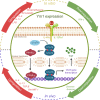An update on Ym1 and its immunoregulatory role in diseases
- PMID: 35967383
- PMCID: PMC9366555
- DOI: 10.3389/fimmu.2022.891220
An update on Ym1 and its immunoregulatory role in diseases
Abstract
Ym1 is a rodent-specific chitinase-like protein (CLP) lacking catalytic activity, whose cellular origins are mainly macrophages, neutrophils and other cells. Although the detailed function of Ym1 remains poorly understood, Ym1 has been generally recognized as a fundamental feature of alternative activation of macrophages in mice and hence one of the prevalent detecting targets in macrophage phenotype distinguishment. Studies have pointed out that Ym1 may have regulatory effects, which are multifaceted and even contradictory, far more than just a mere marker. Allergic lung inflammation, parasite infection, autoimmune diseases, and central nervous system diseases have been found associations with Ym1 to varying degrees. Thus, insights into Ym1's role in diseases would help us understand the pathogenesis of different diseases and clarify the genuine roles of CLPs in mammals. This review summarizes the information on Ym1 from the gene to its expression and regulation and focuses on the association between Ym1 and diseases.
Keywords: Ym1/Chil3; chitinase like protein; immunoregulatory roles; inflammation related diseases; innate immunity.
Copyright © 2022 Kang, Li, Pang, Zhu and Meng.
Conflict of interest statement
The authors declare that the research was conducted in the absence of any commercial or financial relationships that could be construed as a potential conflict of interest.
Figures





Similar articles
-
Altered Macrophage Function Associated with Crystalline Lung Inflammation in Acid Sphingomyelinase Deficiency.Am J Respir Cell Mol Biol. 2021 May;64(5):629-640. doi: 10.1165/rcmb.2020-0229OC. Am J Respir Cell Mol Biol. 2021. PMID: 33662226 Free PMC article.
-
Chitinase-like proteins promote IL-17-mediated neutrophilia in a tradeoff between nematode killing and host damage.Nat Immunol. 2014 Dec;15(12):1116-25. doi: 10.1038/ni.3023. Epub 2014 Oct 19. Nat Immunol. 2014. PMID: 25326751 Free PMC article.
-
Pathological examination of Ym1, a chitinase family protein, in Mesocestoides corti-infected mice.Biomed Res. 2022;43(5):161-171. doi: 10.2220/biomedres.43.161. Biomed Res. 2022. PMID: 36244794
-
Role of chitinase-like proteins in cancer.Biol Chem. 2016 Mar;397(3):231-47. doi: 10.1515/hsz-2015-0269. Biol Chem. 2016. PMID: 26733160 Review.
-
Chitinase-like proteins as regulators of innate immunity and tissue repair: helpful lessons for asthma?Biochem Soc Trans. 2018 Feb 19;46(1):141-151. doi: 10.1042/BST20170108. Epub 2018 Jan 19. Biochem Soc Trans. 2018. PMID: 29351964 Review.
Cited by
-
CD206 modulates the role of M2 macrophages in the origin of metastatic tumors.J Cancer. 2024 Jan 21;15(5):1462-1486. doi: 10.7150/jca.91944. eCollection 2024. J Cancer. 2024. PMID: 38356723 Free PMC article.
-
Experimental hepatic encephalopathy causes early but sustained glial transcriptional changes.J Neuroinflammation. 2023 May 29;20(1):130. doi: 10.1186/s12974-023-02814-w. J Neuroinflammation. 2023. PMID: 37248507 Free PMC article.
-
Single-Cell RNA Sequencing Reveals Immunomodulatory Effects of Stem Cell Factor and Granulocyte Colony-Stimulating Factor Treatment in the Brains of Aged APP/PS1 Mice.Biomolecules. 2024 Jul 10;14(7):827. doi: 10.3390/biom14070827. Biomolecules. 2024. PMID: 39062541 Free PMC article.
-
Irreversible evolutionary loss of chitin-degrading ability in the chitinase-like protein Ym1 under positive selection in rodents.Protein Sci. 2023 Apr;32(4):e4620. doi: 10.1002/pro.4620. Protein Sci. 2023. PMID: 36883357 Free PMC article.
-
Ccr2+ Monocyte-Derived Macrophages Influence Trajectories of Acquired Therapy Resistance in Braf-Mutant Melanoma.Cancer Res. 2023 Jul 14;83(14):2328-2344. doi: 10.1158/0008-5472.CAN-22-2841. Cancer Res. 2023. PMID: 37195124 Free PMC article.
References
Publication types
MeSH terms
Substances
LinkOut - more resources
Full Text Sources
Molecular Biology Databases
Miscellaneous

